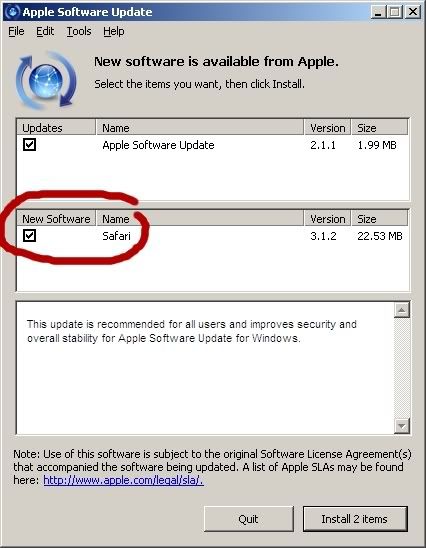More sour Apples...
Okay, so I don't exactly keep my utter despise of Apple a secret. Just a few currently on my mind:
- The iMac is a glorified Fisher Price Activity Center, with plenty of style but little substance.
- The MacBook Air is hilariously underwhelming in functionality, has fewer USB ports than other high-end portables (with such a tight clearance that 3G modems require an extension cable), no Ethernet port, no FireWire port (odd for a data transfer standard initiated by Apple), and heats up so much for a laptop that it can sterilise males when used as such. It's not even the thinnest: the Sharp Actius MM10 takes that claim, and there have been thinner models announced just weeks before the Macbook Air retailed, expecting to market within the next year.
- The MacBook's use of LCDs that only display 260 thousand colours (while promising millions) is despicable, especially when an illusion of a larger pallete is created by dithering the screen.
- Hardware upgrades should be affordable and not involve disposal of the entire computer: the iMac's integration of monitor and CPU, while convenient for purchase and giving a small desk footprint, commits the owner to upgrading both at the same time (exactly how did Steve Jobs boast of Apple Inc.'s green credentials with a straight face in that press release?). This goes hand-in-hand with the soldering of the graphics processor, hard disk and battery to the motherboard, also preventing upgrades without replacing the whole unit.
- Apple's claims that "[OS X] doesn't crash", appearing most prominantly during the Switch ad campaign, are clearly false - even in versions as recent as v10.5/"Leopard" (calling it a "Kernel Panic" in the online support documentation is just a nicety to avoid using the word "crash"; they are one and the same).
- Speaking of "Leopard", the new OS X release that promised lots:
- the translucent, blurry menu bar is intolerable;
- the once almost-usable Dock has had a lot of functionality stunted by eye-candy, such as a reflective and 3D Dock;
- that blue-light active program indicator is almost invisible compared to the old black triangles from days of yore;
- similar "stacks" are indistinguishable from one another; and
- the Dock is almost as big as my nuts at its default size without auto-hide switched on
- Apple's draconian insistence that you must use their software when you don't actually need/want it. In porting iTunes onto Windows, Apple have made the assumption that their market are still the type of person that needs their software upgrading for them automatically. We don't. If there's a need to update individual software releases, tell us why there should be any need to, and let the user decide. Nonetheless, the iTunes/Quicktime installation also drops a copy of Apple Software Update onto your computer, whether you want it or not. While on Mac OS this is designed to give incremental updates of the applications, drivers and firmware, the Windows port gives these:
- iTunes (periodically);
- Quicktime (can one version really differ from another?);
- Bonjour, a crappy implementation of Zeroconf - installed silently, for no reason; and
- Safari, a browser that may pass Acid2, but is deemed so unsecure that it has been refused by PayPal and recently was shown to feature an exploit in that could read the contents of a file located on the user's desktop (at a recent CanSecWest security conference a user was able to physically interact with Mac OS X from Safari). Whether or not you have a copy of Safari on your computer, this is selected by default:

...which borders on malware distribution practices. Apple's charismatic response was that this setup is "to make it easy and convenient for both Mac and Windows users to get the latest Safari update from Apple." Apple's new stance is to put Safari in a separate section of Apple Software Update, but to still keep that check box checked, as shown above on a newly-setup Windows PC with no Safari on it!
Fuck that. If I wanted to update (or install) Safari, I'd choose to do that. Otherwise, quit drowning my computer with crap.
- My biggest gripe, however, is the refusal to equalise prices cross-borders; I should be able to purchase tracks from the iTunes Store at the same cost in the United Kingdom as, say, the iTunes Store in Germany. In the UK, we pay GBP£0.79 per audio track, while members of the Eurozone can purchase tracks for EUR€0.99 each, equating to GBP£0.68 in sterling. Ignoring the fact that those with United States billing addresses may buy tracks for USD$0.99 (GBP£0.49 in sterling), we're paying the highest price in Europe. As the European countries served by iTunes - Austria, Belgium, Finland, France, Germany, Greece, Italy, Luxembourg, Netherlands, Portugal, Spain and the United Kingdom - are all European Union (EU) member states (whether or not they are in the Eurozone), we should expect pan-European prices. Not doing so is illegal: one of the tenets of the EU trading bloc is its single market (unlike NAFTA), removing technical and fiscal barriers to trade among member states to give freedom of movement of capital, labour, goods and services; allowing differing prices to different nations within the EU is not compliant with WTO rules, much less those of the EU, regardless of the nationality of the vendor. Oh yeah, and blaming this on the local pricing of each country's music industry is not gonna wash with us! If this were true, Apple should shop them in and report them to the EU.